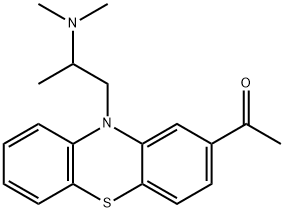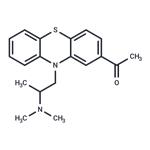Manufacturing Process
In a 1 liter flask, equipped with stirrer, thermometer and nitrogen inlet, 241.0
g of 2-acetylphenothiazine (1 mole) is dissolved in 300 ml of dry
dimethylformamide. When the 2-acetylphenothiazine is almost completely
soluble, to this solution is added 275 ml of a 4 N solution of 1-dimethylamino-
2-chloropropane in toluene.
The mixture is heated to 50°C and 26.0 g (1.08 moles) of sodium hydride is
added portion-wise, maintaining the temperature at 50°-60°C. The addition
should take about 1 h. The reaction is allowed to stir for 3 h at 50°-60°C. Any
excess hydride is destroyed by the cautious addition of 10 ml methanol, and
the reaction mix is poured into 800 ml of 20% acetic acid.
The toluene layer is separated and extracted with 150 ml of 20% acetic acid,
and discarded. The acid solutions are combined and washed once with
toluene. The toluene is discarded. Fresh toluene (200 ml) is added and caustic
solution is added with cooling and stirring until the pH is 9 or above. The
toluene layer is separated. The aqueous layer is extracted once more with 75
ml of toluene and discarded. The toluene extracts are combined, given a small
water wash, and concentrated. The residue is distilled yielding 10-[2-
(dimethylamino)propyl]-2-acetylphenothiazine.




